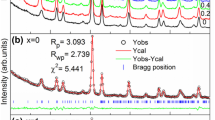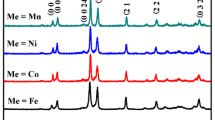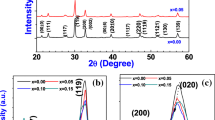Abstract
Here, we report the structure evolution, magnetic and ferroelectric properties in Co-doped 4- and 3-layered intergrowth Aurivillius compounds Bi4NdTi3Fe1-xCoxO15-Bi3NdTi2Fe1-xCoxO12-δ. The compounds suffer a structure evolution from the parent 4-layered phase (Bi4NdTi3FeO15) to 3-layered phase (Bi3NdTi2CoO12-δ) with increasing cobalt do** level from 0 to 1. Meanwhile the remanent magnetization and polarization show opposite variation tendencies against the do** level, and the sample with x = 0.3 has the largest remanent magnetization and the smallest polarization. It is believed that the Co concentration dependent magnetic properties are related to the population of the Fe3+ -O-Co3+ bonds, while the suppressed ferroelectric polarization is due to the enhanced leakage current caused by the increasing Co concentration. Furthermore, the samples (x = 0.1–0.7) with ferromagnetism show magnetoelectric coupling effects at room temperature. The results indicate that it is an effective method to create new multiferroic materials through modifying natural superlattices.
Similar content being viewed by others
Introduction
The search for multiferroic materials combining electric and magnetic properties in a single phase has attracted a lot of attention in the perspective of future spintronic or magnetoelectronic devices1,2,3. Unfortunately, only a handful of single phase multiferroics have been discovered so far, and most of them are not suitable for practical applications at present, either because the room temperature polarization/magnetization is too small or their mutual coupling is too weak4,5,6. Therefore people are still hunting for new multiferroic systems2,7. One possible route for designing single-phase multiferroic materials is to start from a series of well-established ferroelectrics and create additional functionality by incorporating magnetic ions into these systems1,8,9. A promising class of materials for this purpose is the so-called Aurivillius phases with a naturally layered perovskite-related crystal structure, which consists of n perovskite-like layers (An−1BnO3n+1)2−, stacked along the [001] direction, and separated by fluorite-like (Bi2O2)2+ layers10. The overall chemical composition is thus Bi2An−1BnO3n+3, where many different cations can be incorporated on the A and B sites within the perovskite-like layers11. The series of Aurivillius phase compounds are well known for their excellent ferroelectric properties with very low fatigue12, and offer great potential for tailoring specific properties by varying different ionic compositions or even number of layers8,13,14. By do** with magnetic cations, the bismuth-based Aurivillius phase compounds were found to have a room temperature ferromagnetic order besides the natural ferroelectricity, indicating their multiferroic potential8,9,15,16,17. Moreover, the Sm and Co co-doped 3-layered (n = 3) Bi4-xSmxTi3-xCoxO12-δ (0 ≤ x ≤ 0.07) ceramics show a magnetoelectric (ME) coupling coefficient of 0.65 mV/cm∙Oe at room temperature15, while the 5-layered (n = 5) SrBi5Fe0.5Co0.5Ti5O18 ceramic was found to show a ME coupling coefficient of 0.27 mV/cm∙Oe8. Thus this kind of material is one of the excellent choices for ME applications and deserves further investigation.
Furthermore, due to the complexity of the structure, an interesting phenomenon called intergrowth has been reported in Aurivillius compounds18,19,20. It has been demonstrated that the ferroelectricity of 4- and 3-layered intergrowth compounds is larger than that of individual 4- or 3-layered compound21,22. However, the effects of magnetic ions do** on ferroelectric, magnetic and multiferroic properties are still unknown in such an intergrowth superlattice system.
Here we successfully synthesized a series of Bi4NdTi3Fe1-xCoxO15-Bi3NdTi2Fe1-xCoxO12-δ (BNTFC-x) compounds with different ratios of 4- and 3-layered Aurivillius intergrowth superlattice structure. It was found that as the cobalt do** concentration increases from 0 to 1, the samples suffer a structure evolution from 4-layers to 3-layers. The observed magnetic and ferroelectric properties can be well explained by the magnetic ions do** and the intergrowth structure evolution.
Results and Discussion
To clarify the structure evolution of the Bi4NdTi3Fe1-xCoxO15-Bi3NdTi2Fe1-xCoxO12-δ (BNTFC-x) compounds, the high-angle annular dark-field (HAADF) images and selected area electron diffraction (SAED) were performed, as shown in Fig. 1. In the HAADF images, the big bright spots stand for the location of the Bi/Nd atoms while the small spots located near the center of Bi/Nd lattice represent the Ti/Fe/Co atoms as depicted in the inset of Fig. 1(b) (4-layered) and (e) (3-layered). It can be seen that the fluorite-like (Bi2O2)2+ layers and peroskite-like (An−1BnO3n+1)2− layers are stacking along c direction, indicating that all compounds have a typical Aurivillius layered structure. From the SAED patterns, the electron incidence direction, namely the view direction, can be obtained, as marked in Fig. 1. As shown in Fig. 1(a), the 4-layered lattice can be clearly distinguished for x = 0.1. As the Co concentration increases to 0.3, the 3-layered lattice begins to appear as shown in Fig. 1(b). While x increases to 0.5, the 4-layered and 3-layered structures alternately stack along the [001] direction (shown in Fig. 1(c)). With the x further increasing to 0.7, the 3-layered structure starts to dominate (shown in Fig. 1(d)), and at last for x = 0.9 and 1 components, the 4-layered Aurivillius structure almost disappears (shown in Fig. 1(e) and (f)). The HAADF results indicate that increasing Co do** level makes the BNTFC-x compound experiencing a structure evolution from 4-layered structure to 3-layered structure. This intergrowth phenomenon has also been reported in SrxBi7-xFe1.5Co1.5Ti3O21-δ, which undergoes a phase evolution from 6-layers to 4-layers when the concentration of A-site doped strontium increases from 0 to 114.
HAADF images and SAED patterns of BNTFC–x: (a) x = 0.1; (b) x = 0.3; (c) x = 0.5; (d) x = 0.7; (e) x = 0.9; (f) x = 1.0. The big white spots represent the Bi (Nd) atoms, while the small spots located near the center of Bi/Nd lattice represent the Ti/Fe/Co atoms. The inset in (b) and (e) is a magnifying image for 4- and 3-layered phase, respectively, where the azury and green sphere denote Bi/Nd and Ti/Fe/Co atoms, respectively. For (a,c,e and f), the viewing direction is along [100], while for (b) and (c) the viewing direction is along  . For x ≤ 0.5, the marked diffraction spots belong to 4-layered phase, while for x > 0.5 the marked diffraction spots belong to 3-layered phase.
. For x ≤ 0.5, the marked diffraction spots belong to 4-layered phase, while for x > 0.5 the marked diffraction spots belong to 3-layered phase.
The room temperature powder X-ray diffraction (XRD) patterns with data refined by Rietveld Method via Materials Analysis Using Diffraction (MAUD) program23,24 for BNTFC-x ceramics are shown in Fig. 2. Quantitative analysis confirms that three phases, including 4-layered phase Bi4NdTi3Fe1-xCoxO15 (n = 4), 3-layered phase Bi3NdTi2Fe1-xCoxO12-δ (n = 3), and an impurity phase Bi12TiO20 coexist in the BNTFC-x system. The refinements were based on space group A21am (No. 36) for 4-layered phase25, B2cb (No. 41) for 3-layered phase26 and I23 (No. 197) for Bi12TiO20 phase27. The good matching between experimental and calculated XRD patterns is demonstrated by the low Rw value for all compounds (Rw ≤ 6.15%), as shown in Fig. 2. To better understand and analysis the structures, the schematic structure diagrams of 4- and 3-layered phases are shown in Fig. 3(a) and (b), respectively. The Ti, Fe and Co cations were set to occupy the same position (B site in the center of each perovskite structure in the perovskite-like layer) with fixed Ti occupancy (3/4 in 4-layer phase, and 2/3 in 3-layer phase) and changeable occupancies of Fe and Co with the cobalt nominal do** level ((1-x)/4 for Fe and x/4 for Co in 4-layer phase, (1-x)/3 for Fe and x/3 for Co in 3-layer phase).
The lattice parameters a and b obtained by refinement gradually decrease and c increases in both 4-layered (Fig. 4(a)) and 3-layered (Fig. 4(b)) phase with increasing cobalt concentration. As shown in Fig. 4(c), the volume fraction of 4- (3-) layered phase gradually decreases (increases) from 100% (0) to 0 (85.34%) as x increases from 0 to 1, also confirming that the samples suffer a structure evolution from 4-layered phase to 3-layered phase. The fraction of the Bi12TiO20 phase increases with the Co concentration in the samples with x < 0.5, and keeps at about 15% for x ≥ 0.5. The impurity phase (Bi12TiO20) is induced by the element loss during the structure evolution process, similar to the situation in SrxBi7-xFe1.5Co1.5Ti3O21-δ system14. According to the results of XRD patterns and HAADF images, the BNTFC-x compounds undergo a structure evolution with a two-phase modulated superlattice when the concentration of Co changes. In other words, the micro superlattice structure can be naturally controlled by the cobalt do** level.
In addition, the Fe/Co ions can occupy two non-equivalent positions (center of inner and outer octahedrons between two (Bi2O2)2+ layers) in 4- and 3-layered structures. In 4-layered Bi5Ti3FeO15, these octahedrally coordinated center sites are shared between Ti4+ and Fe3+ cations, and a quasi-random cation distribution is observed in experiments25,28. Similarly, it can be assumed that Ti4+, Fe3+, and Co3+ cations are randomly distributed in the octahedral center positions in both 4- and 3-layered structures. In perovskite-like compounds the most probable valence states of Fe and Co are + 3. According to Goodenough-Kanamori rules9,29,30,31, Fe3+ -O-Fe3+ and Co3+ -O-Co3+ superexchange interactions with the nature of antiferromagnetism exist in x = 0 and 1 samples, respectively, making the ground state of these two compounds to be antiferromagnetic. Based on the discussions on the occupations and interactions of Fe/Co cations, it can be expected that the structure evolution of BNTFC-x will have a significant impact on the physical properties, e.g. magnetism and ferroelectricity. To verify this, we systemically measured the magnetic and ferroelectric properties of BNTFC-x compounds, and discussed the relationship between the structure and properties as follows.
The room temperature magnetic hysteresis loops for BNTFC-x are shown in Fig. 5(a). The magnetization (M) versus applied field (H) curves of x = 0.1 to 0.7 samples show a typical ferromagnetic hysteresis feature, while those for x = 0, 0.9 and 1.0 show a linear behavior. The remanent magnetization (Mr) and saturation magnetization (Ms, obtained from the M-H curves after deducting the linear part) gradually increase and reach a maximum with increasing Co content to x = 0.3, and then decreases with further increasing Co content, as shown in Fig. 5(b). It is known that the ground state of Bi4NdTi3FeO15 (x = 0) is antiferromagnetic. When Co3+ replaces parts of Fe3+ cations, some Fe3+ -O-Fe3+ chains will be destroyed, while the antiparallel Fe3+ and Co3+ superexchange interaction appears. Considering the difference of magnetic moments between a single Fe3+ (5.916 μB) and a single Co3+ (4.899 μB)32, the interaction of Fe3+ -O-Co3+ should contribute to a net magnetization, as discussed in Bi5Fe0.5Co0.5Ti3O1533 and Bi4NdFe0.5Co0.5Ti3O1516 ceramics. In the situation of x = 0.1, namely 10% Fe3+ ions are substituted by Co3+, the formation of Fe3+ -O-Co3+ bonds results in the appearance of ferromagnetism. In x = 0.3, more Fe3+ -O-Co3+ bonds form, leading to a larger remanent magnetization. While for x > 0.5, the decrease of the amount of Fe3+ -O-Co3+ bonds may lead to the diminution of magnetization. As for x = 0.9, the concentration of Fe3+ ions is too low to construct effective Fe3+ -O-Co3+ order, the system may be antiferromagnetic or paramagnetic at room temperature, just like Bi5Ti3FeO1534. Thus, it can be proposed that the magnetization of BNTFC-x may be mainly contributed by the population of Fe3+ -O-Co3+ local structure due to the cobalt do**33. Besides, the Ti/Fe/Co-O-Ti/Fe/Co angles may be affected by Co substitution35 and structure evolution22, which could also affect the observed magnetic properties. It should be noted that the most prominent remanent magnetization (Mr = 123 memu/g) at x = 0.3 is about 31 times larger than that of Bi5Ti3Fe0.5Co0.5O15 (3.9 memu/g)33, and comparable with that of Bi4NdTi3Fe0.5Co0.5O15 (165 memu/g)16 and Bi4NdTi3Fe0.7Ni0.3O15 (194 memu/g)36.
It has been reported that the do** of an Aurivillius phase with cobalt will lead to the generation of magnetic second-phase inclusions (Co/Fe-rich spinel phases) which volume fraction is too small to be visible in XRD but may be already enough to contribute significant ferromagnetic signal9,37,38. Generally, the Fe and Co-rich magnetic inclusions have a chemical formula Fe3-yCoyO4 (0 ≤ y ≤ 3), and the remanent magnetizations (0–20 emu/g) at room temperature decrease with increasing Co content39,40,41,42,43,44. Following the effective statistical method proposed by M. Schmidt et al.38, the volume fraction of the possible inclusions and their upper limit impact on magnetic contributions (Mi/Mr, where Mi is the remanent magnetization of the inclusions and Mr is that of the specimen) for the worst case scenario were carefully estimated via energy selective backscatter (ESB) image and energy dispersive X-ray analysis (EDX). For the samples with ferromagnetic signals, namely, x = 0.1, 0.3, 0.5, and 0.7, the magnetic contributions to the corresponding specimens of the inclusions are conservatively estimated to be about or smaller than 3.9%, 1.9%, 3.8%, and 1.5%, respectively. While for x = 0.9 and 1.0, the inclusions are paramagnetic at 300 K44,45, and have no magnetic contributions to the main phase. Based on the criteria of the comprehensive framework raised by M. Schmidt et al.38, we believe that the magnetic results do reflect the intrinsic ferromagnetic properties of the main phase. Detailed calculations are presented in Part I of the Supplementary Material.
Figure 6 shows the room temperature polarization (P) versus electric field (E) curves of BNTFC-x samples, indicating that all specimen have a good ferroelectricity. With increasing the cobalt do** concentration, the remanent polarization Pr first decreases and reaches the minimum (4.26 μC/cm2) at x = 0.3, and then gradually increases with further do**. The obtained Pr for BNTFC-x is better than Bi4NdTi3Fe0.5Co0.5O15 (1 μC/cm2)16 as well as Bi4NdTi3Fe0.7Ni0.3O15 (4.3 μC/cm2)36, and comparable to that of Bi5Ti3Fe0.5Co0.5O15 ceramics (6.5 μC/cm2)33. While the coercive field Ec of BNTFC-x keeps decreasing as the cobalt concentration increases, which should be related to the smaller coercive field in 3-layered phase than 4-layered phase21. It should be noted that the Pr-x curve (Fig. 6(b), black line) shows an opposite variation tendency as compared with Mr-x curve (Fig. 5(b), black line), indicating a correlation between ferroelectricity and magnetism. For example, the minimum Pr and maximum Mr are observed in x = 0.3 sample. The Pr-x curve indicates that the Pr values of the 4- and 3- layered intergrowth compounds (0.1 < x < 0.9) are smaller than that of individual 4- (x = 0) or 3- (x = 1) layered compound, which is opposite to previous reports (no magnetic ions doped in the samples)21,22, probably due to the magnetic ion do** in our system. Figure 6(b) (red line) shows the resistivity (ρ) for the BNTFC-x at room temperature. The similar variation tendency of Pr and ρ implies that the weakened ferroelectricity should be attributed to the increasing leakage current. Usually, magnetic ion do** will reduce the resistivity of a dielectric material and weaken the ferroelectric performance due to the strengthening of exchange interaction between magnetic ionsFull size image









